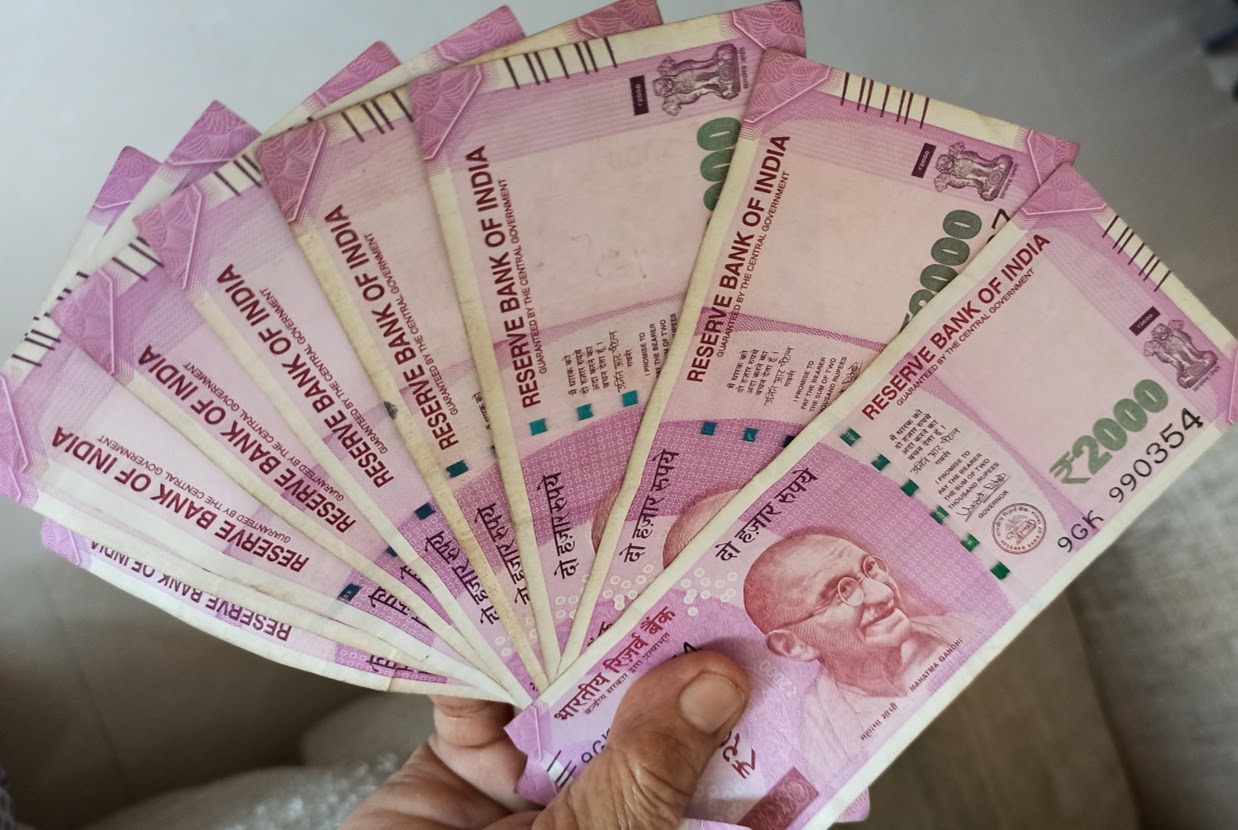Three worries persist even as the Indian rupee sank to its lifetime low in early trade today, touching 76.98 to a dollar before closing at 76.97.
As Russian forces continued bombardment of Ukrainian cities, more pressure is set to come from oil prices, dollar shortage and weak equity markets on the rupee to breach the 78-mark. The weakening of the rupee will push imported inflation up and widen the current account deficit.
“Oil prices shock, rise in US dollar index and relentless FPI (foreign portfolio investors) outflow in the equity market caused the rupee to fall towards an all-time low. We expect the rupee to remain under pressure till oil prices fall. A range of 76.50 and 78.50 can be seen over the near term," said Anindya Banerjee, DVP, Currency Derivatives & Interest Rate Derivatives at Kotak Securities Ltd.
Last week, the rupee saw its worst weekly loss in 11 months despite the RBI selling $4 billion through public sector banks to shield the Indian currency. On Friday, the rupee tumbled to 76.22 per dollar during intraday before closing at 76.16. This was a tad higher than the rupee's earlier all-time low of 76.88 per dollar in April 2020 after the outbreak of Covid-19.
“The RBI intervened in the market last week to the tune of around $4 billion. With forex reserves being high, the central bank has room to firewall the rupee from a sharp fall,” the treasury head of a leading public sector bank said.
While inflation will be the bigger worry, India has forex reserves of $631.52 billion that will provide comfort to the RBI in protecting the rupee from nosediving.
“Oil prices are rising and the geopolitical climate will put pressure on the rupee. Given inflation, RBI will be pressured to stop a slide of the rupee. That being said, the RBI does have the resources to manage the situation,” said currency expert Jamal Mecklai, who heads Mecklai Financial.
As the battle in Ukraine rages on, ramifications are being felt across the globe. After the US said it was discussing a potential embargo on Russian supplies with its allies, Brent crude rose to above $139 a barrel before falling to below $130. Just last week, the price of Brent crude had climbed 20% amid fears of a shortage of oil.
Western countries have so far not imposed sanctions on Russian oil imports. With Russia supplying about a third of Europe’s oil needs, there is fear that it will further spike energy prices, which are already at record high levels.
“My biggest worry is the oil prices,” said Banerjee. He believes the impact would be debilitating if the oil price is on fire, rising up to $130 to $140 a barrel like it did in 2008. That is a small distance away and some analysts think the all-time high of $147.50, reached in July 2008, could be crossed if the Ukraine crisis continues.
Oil drove much of the widening of India’s trade deficit in February. “Oil imports rose by nearly 43% month-on-month after a 31% decline in January, while core imports (non-oil, gold and gems and jewellery) rose by only 1.9% (after a flat reading in January). Similarly, the sequential momentum in oil exports overshadowed that of core exports. We believe this reflects not only higher oil prices, but also a rise in volumes, as the economy rebounded from the third wave,” analysts at Nomura wrote in a note.
Russia, which is the world’s second top producer of crude oil after Saudi Arabia, supplies 8% of the global requirements of oil. ING Bank said in a report that if Russian energy exports are fully targeted, then Brent crude could climb to $150 per barrel.
“Given the lag between spot oil prices and the signing of new oil contracts, we should see the full effect of the current rise in oil prices in the April/May trade data. Secondly, broader cost push pressures are also likely on other key imports like fertilizers, coal, edible oil, natural gas and metals. Thirdly, we expect gold imports to rise, reflecting both price effects and higher volumes, as a hedge against inflation,” Nomura said in its report.
There is also a fear that Russia’s war on Ukraine will create a dollar shortage, especially at the shorter end of money markets across the world. The Indian market is showing less strain at this stage but it can build up as the import bill climbs. Since India imports more than two-thirds of its oil requirements, rising crude prices will trigger imported inflation and widen the current account deficit.
“Dollar shortage can become a big worry. “Already big US banks like JP Morgan are refusing redemptions in funds with exposure to Russian equities,” said Banerjee.
The Russian financial institutions, the central bank and the corporates were generating a huge surplus in dollars because of the country’s current account surplus, pegged at $400 billion, and large exports of a whole host of commodities including oil and gas. This excess used to be invested in the offshore Euro dollar market from where the banks, the shadow banks and other financial institutions used to borrow. This flow is shut out and is creating shortage, Banerjee explained.
India could be on the way to larger trade deficits. The predominance of oil imports in driving the larger trade deficit in February suggests the ongoing Russia-Ukraine conflict could affect imports through the price channel and possibly exports through the volume channel. "We estimate a 10% rise in global crude oil prices would widen India’s current account deficit by 0.3% of GDP,” the Nomura report said.
On the exports front, while there are some downside risks due to weaker demand from Russia, the impact should be small, as Russia accounts for only 0.8% of total exports. Pharmaceutical products, telecom instruments, iron & steel and marine products comprise the bulk of India’s exports to the Commonwealth of Independent States region. However, if the slowdown in Russia’s economy spills over more broadly, risks to export demand would increase. On the flip side, higher commodity prices should help with commodity-based exports like petroleum products and metals.
"On balance, we believe higher commodity prices will play a key role in further widening the trade deficit. We expect the current account deficit to widen to 2.6% of GDP in FY23 (year ending March 2023) from 1.7% of GDP in FY22, assuming oil prices average USD86.6/bbl; so, if oil prices sustain at current high levels, then risks are skewed towards a much wider deficit,” the report added.
When RBI meets for its next monetary policy review in April, it will have to revisit its inflation projections in the wake of the war in Ukraine and rise in oil and commodity prices. The central bank expects headline retail inflation to average at 4.5% in the next financial year, easing from an estimated 5.3% this fiscal. But economists are of the view that the risks from oil and commodity prices are not priced in this estimate.
“Inflation is bound to rise with commodity prices remaining high. The ramifications will be far reaching with commodity prices rising sharply across the spectrum,” said Bhaskar Panda, senior regional treasury head at HDFC Bank.
Besides oil, India will face inflationary pressures from other imported items. India depends on Russia for defence, fertilisers and potash. “About 90% of the spare parts for our army tanks are from Russia. So, there is a lot of trade ties with that country which is now hit with sanctions at so many levels. This will certainly have inflationary pressures in the country,” said the treasury head of a mid-sized public sector bank.
One currency that has been deeply impacted is the rouble, which has shed a third of its value after sanctions were imposed against Russia by the Western countries. The free-fall of the rouble could not be halted by the $640 billion of reserves Russia’s central bank had built over the years as the sanctions included the freezing of its assets by the US, the European Union, the UK and Canada. Several Russian banks were also barred from global payments system SWIFT.
Cast under the shadow of Western sanctions, India is exploring bilateral trade with Russia in terms of rupee-rouble agreement. This will be at a time when the rupee has appreciated against the rouble, but how the West will take to this is unknown at this stage.
The third worry is a long trail of weak equity markets left behind by the war. FPIs have been deserting the equity and bond markets, since the US Federal Reserve decided to increase interest rates and more sharply after the Russian invasion of Ukraine.
“Dollar shortage and the rise in the dollar index are inter-connected. Many international funds who have investments in Russia and also Europe have suffered deep losses and are forced to sell in other markets to pare their losses. In India, the FPIs have sold $2.3 billion since March 1. And outflows for the 11 days of war could have easily crossed $3 billion,” said Banerjee.
The war in Ukraine and the collective will of the Western countries to punish President Vladimir Putin’s Russia with sanctions has made one thing clear: the Indian rupee will toss around this way and that for some time, at least.




